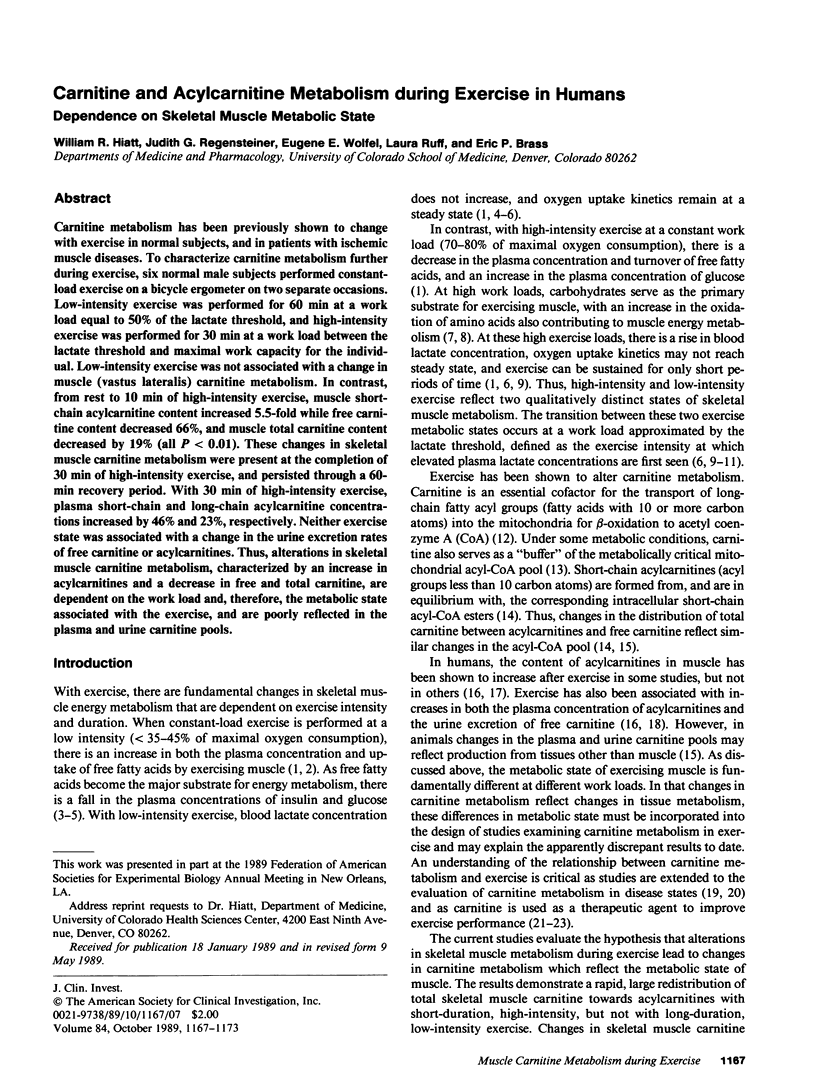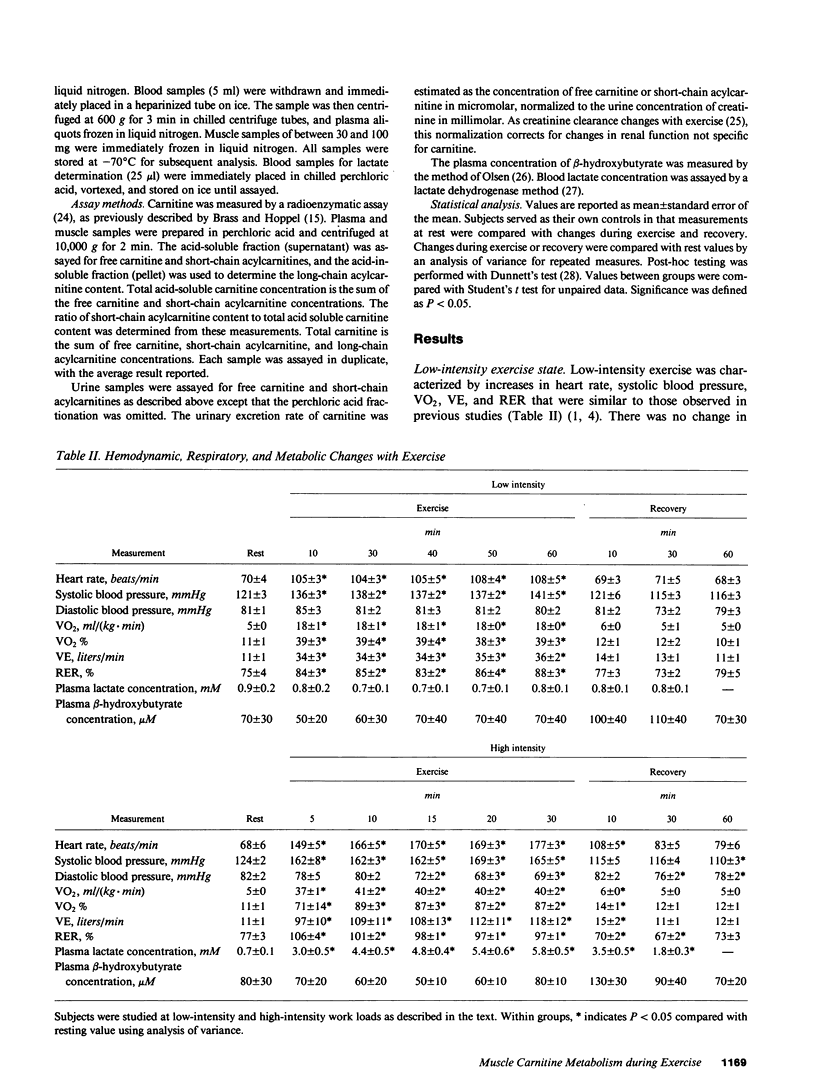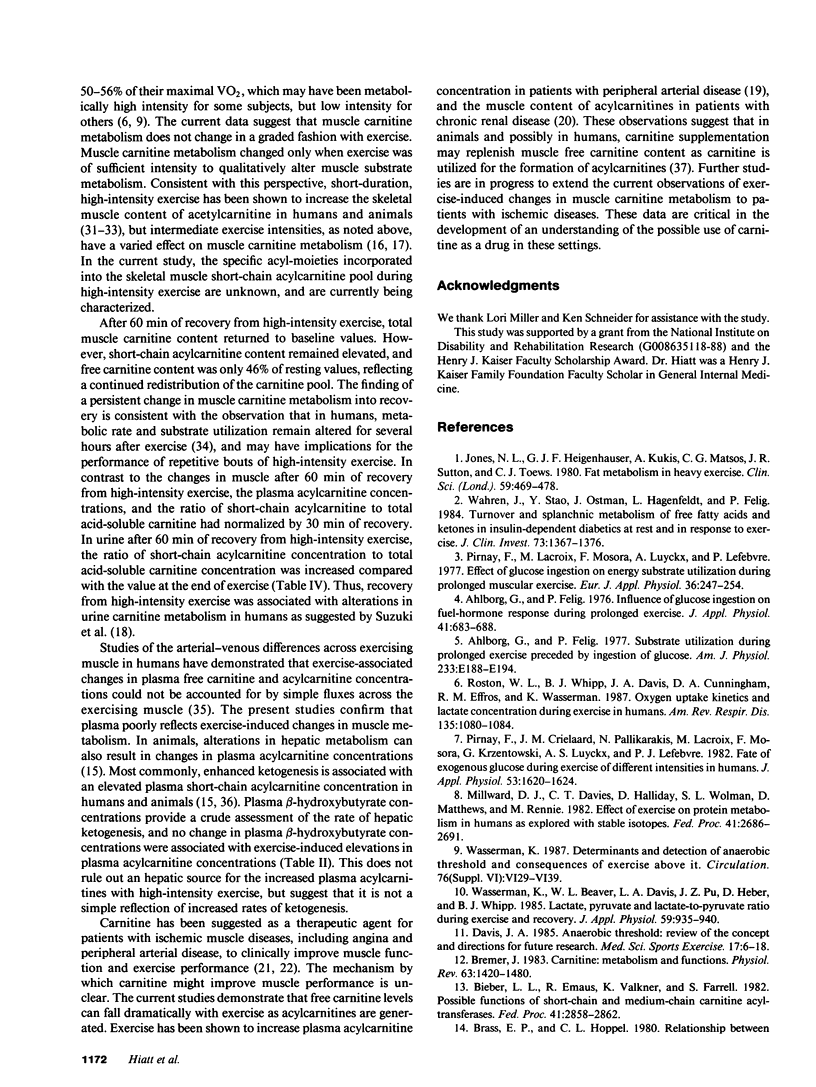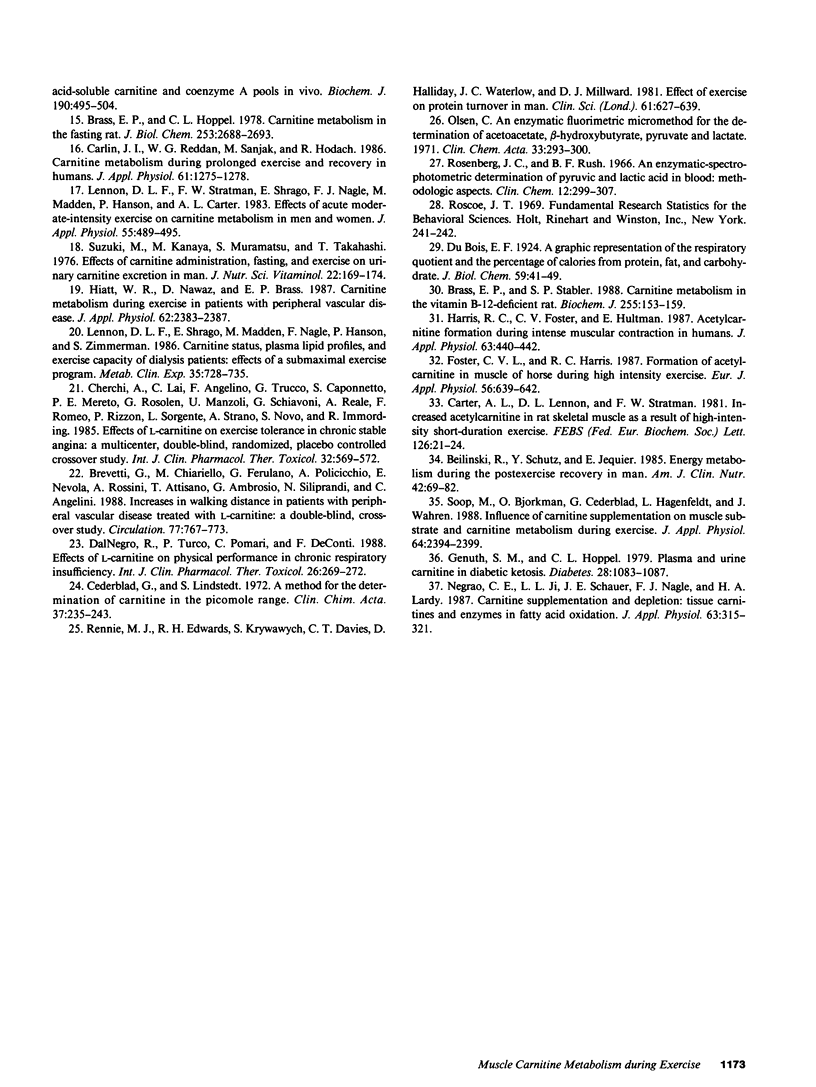Abstract
Carnitine metabolism has been previously shown to change with exercise in normal subjects, and in patients with ischemic muscle diseases. To characterize carnitine metabolism further during exercise, six normal male subjects performed constant-load exercise on a bicycle ergometer on two separate occasions. Low-intensity exercise was performed for 60 min at a work load equal to 50% of the lactate threshold, and high-intensity exercise was performed for 30 min at a work load between the lactate threshold and maximal work capacity for the individual. Low-intensity exercise was not associated with a change in muscle (vastus lateralis) carnitine metabolism. In contrast, from rest to 10 min of high-intensity exercise, muscle short-chain acylcarnitine content increased 5.5-fold while free carnitine content decreased 66%, and muscle total carnitine content decreased by 19% (all P less than 0.01). These changes in skeletal muscle carnitine metabolism were present at the completion of 30 min of high-intensity exercise, and persisted through a 60-min recovery period. With 30 min of high-intensity exercise, plasma short-chain and long-chain acylcarnitine concentrations increased by 46% and 23%, respectively. Neither exercise state was associated with a change in the urine excretion rates of free carnitine or acylcarnitines. Thus, alterations in skeletal muscle carnitine metabolism, characterized by an increase in acylcarnitines and a decrease in free and total carnitine, are dependent on the work load and, therefore, the metabolic state associated with the exercise, and are poorly reflected in the plasma and urine carnitine pools.
Full text
PDF






Selected References
These references are in PubMed. This may not be the complete list of references from this article.
- Ahlborg G., Felig P. Influence of glucose ingestion on fuel-hormone response during prolonged exercise. J Appl Physiol. 1976 Nov;41(5 Pt 1):683–688. doi: 10.1152/jappl.1976.41.5.683. [DOI] [PubMed] [Google Scholar]
- Bieber L. L., Emaus R., Valkner K., Farrell S. Possible functions of short-chain and medium-chain carnitine acyltransferases. Fed Proc. 1982 Oct;41(12):2858–2862. [PubMed] [Google Scholar]
- Bielinski R., Schutz Y., Jéquier E. Energy metabolism during the postexercise recovery in man. Am J Clin Nutr. 1985 Jul;42(1):69–82. doi: 10.1093/ajcn/42.1.69. [DOI] [PubMed] [Google Scholar]
- Brass E. P., Hoppel C. L. Carnitine metabolism in the fasting rat. J Biol Chem. 1978 Apr 25;253(8):2688–2693. [PubMed] [Google Scholar]
- Brass E. P., Hoppel C. L. Relationship between acid-soluble carnitine and coenzyme A pools in vivo. Biochem J. 1980 Sep 15;190(3):495–504. doi: 10.1042/bj1900495. [DOI] [PMC free article] [PubMed] [Google Scholar]
- Brass E. P., Stabler S. P. Carnitine metabolism in the vitamin B-12-deficient rat. Biochem J. 1988 Oct 1;255(1):153–159. doi: 10.1042/bj2550153. [DOI] [PMC free article] [PubMed] [Google Scholar]
- Bremer J. Carnitine--metabolism and functions. Physiol Rev. 1983 Oct;63(4):1420–1480. doi: 10.1152/physrev.1983.63.4.1420. [DOI] [PubMed] [Google Scholar]
- Brevetti G., Chiariello M., Ferulano G., Policicchio A., Nevola E., Rossini A., Attisano T., Ambrosio G., Siliprandi N., Angelini C. Increases in walking distance in patients with peripheral vascular disease treated with L-carnitine: a double-blind, cross-over study. Circulation. 1988 Apr;77(4):767–773. doi: 10.1161/01.cir.77.4.767. [DOI] [PubMed] [Google Scholar]
- Carlin J. I., Reddan W. G., Sanjak M., Hodach R. Carnitine metabolism during prolonged exercise and recovery in humans. J Appl Physiol (1985) 1986 Oct;61(4):1275–1278. doi: 10.1152/jappl.1986.61.4.1275. [DOI] [PubMed] [Google Scholar]
- Carter A. L., Lennon D. L., Stratman F. W. Increased acetyl carnitine in rat skeletal muscle as a result of high-intensity short-duration exercise. Implications in the control of pyruvate dehydrogenase activity. FEBS Lett. 1981 Apr 6;126(1):21–24. doi: 10.1016/0014-5793(81)81023-x. [DOI] [PubMed] [Google Scholar]
- Cederblad G., Lindstedt S. A method for the determination of carnitine in the picomole range. Clin Chim Acta. 1972 Mar;37:235–243. doi: 10.1016/0009-8981(72)90438-x. [DOI] [PubMed] [Google Scholar]
- Cherchi A., Lai C., Angelino F., Trucco G., Caponnetto S., Mereto P. E., Rosolen G., Manzoli U., Schiavoni G., Reale A. Effects of L-carnitine on exercise tolerance in chronic stable angina: a multicenter, double-blind, randomized, placebo controlled crossover study. Int J Clin Pharmacol Ther Toxicol. 1985 Oct;23(10):569–572. [PubMed] [Google Scholar]
- Dal Negro R., Turco P., Pomari C., De Conti F. Effects of L-carnitine on physical performance in chronic respiratory insufficiency. Int J Clin Pharmacol Ther Toxicol. 1988 May;26(5):269–272. [PubMed] [Google Scholar]
- Davis J. A. Anaerobic threshold: review of the concept and directions for future research. Med Sci Sports Exerc. 1985 Feb;17(1):6–21. [PubMed] [Google Scholar]
- Foster C. V., Harris R. C. Formation of acetylcarnitine in muscle of horse during high intensity exercise. Eur J Appl Physiol Occup Physiol. 1987;56(6):639–642. doi: 10.1007/BF00424803. [DOI] [PubMed] [Google Scholar]
- Genuth S. M., Hoppel C. L. Plasma and urine carnitine in diabetic ketosis. Diabetes. 1979 Dec;28(12):1083–1087. doi: 10.2337/diab.28.12.1083. [DOI] [PubMed] [Google Scholar]
- Harris R. C., Foster C. V., Hultman E. Acetylcarnitine formation during intense muscular contraction in humans. J Appl Physiol (1985) 1987 Jul;63(1):440–442. doi: 10.1152/jappl.1987.63.1.440. [DOI] [PubMed] [Google Scholar]
- Hiatt W. R., Nawaz D., Brass E. P. Carnitine metabolism during exercise in patients with peripheral vascular disease. J Appl Physiol (1985) 1987 Jun;62(6):2383–2387. doi: 10.1152/jappl.1987.62.6.2383. [DOI] [PubMed] [Google Scholar]
- Jones N. L., Heigenhauser G. J., Kuksis A., Matsos C. G., Sutton J. R., Toews C. J. Fat metabolism in heavy exercise. Clin Sci (Lond) 1980 Dec;59(6):469–478. doi: 10.1042/cs0590469. [DOI] [PubMed] [Google Scholar]
- Lennon D. L., Shrago E., Madden M., Nagle F., Hanson P., Zimmerman S. Carnitine status, plasma lipid profiles, and exercise capacity of dialysis patients: effects of a submaximal exercise program. Metabolism. 1986 Aug;35(8):728–735. doi: 10.1016/0026-0495(86)90240-4. [DOI] [PubMed] [Google Scholar]
- Lennon D. L., Stratman F. W., Shrago E., Nagle F. J., Madden M., Hanson P., Carter A. L. Effects of acute moderate-intensity exercise on carnitine metabolism in men and women. J Appl Physiol Respir Environ Exerc Physiol. 1983 Aug;55(2):489–495. doi: 10.1152/jappl.1983.55.2.489. [DOI] [PubMed] [Google Scholar]
- Millward D. J., Davies C. T., Halliday D., Wolman S. L., Matthews D., Rennie M. Effect of exercise on protein metabolism in humans as explored with stable isotopes. Fed Proc. 1982 Aug;41(10):2686–2691. [PubMed] [Google Scholar]
- Negrao C. E., Ji L. L., Schauer J. E., Nagle F. J., Lardy H. A. Carnitine supplementation and depletion: tissue carnitines and enzymes in fatty acid oxidation. J Appl Physiol (1985) 1987 Jul;63(1):315–321. doi: 10.1152/jappl.1987.63.1.315. [DOI] [PubMed] [Google Scholar]
- Olsen C. An enzymatic fluorimetric micromethod for the determination of acetoacetate, -hydroxybutyrate, pyruvate and lactate. Clin Chim Acta. 1971 Jul;33(2):293–300. doi: 10.1016/0009-8981(71)90486-4. [DOI] [PubMed] [Google Scholar]
- Pirnay F., Crielaard J. M., Pallikarakis N., Lacroix M., Mosora F., Krzentowski G., Luyckx A. S., Lefebvre P. J. Fate of exogenous glucose during exercise of different intensities in humans. J Appl Physiol Respir Environ Exerc Physiol. 1982 Dec;53(6):1620–1624. doi: 10.1152/jappl.1982.53.6.1620. [DOI] [PubMed] [Google Scholar]
- Pirnay F., Lacroix M., Mosora F., Luyckx A., Lefebvre P. Effect of glucose ingestion on energy substrate utilization during prolonged muscular exercise. Eur J Appl Physiol Occup Physiol. 1977 May 10;36(4):247–254. doi: 10.1007/BF00423050. [DOI] [PubMed] [Google Scholar]
- Rennie M. J., Edwards R. H., Krywawych S., Davies C. T., Halliday D., Waterlow J. C., Millward D. J. Effect of exercise on protein turnover in man. Clin Sci (Lond) 1981 Nov;61(5):627–639. doi: 10.1042/cs0610627. [DOI] [PubMed] [Google Scholar]
- Rosenberg J. C., Rush B. F. An enzymatic-spectrophotometric determination of pyruvic and lactic acid in blood. Methodologic aspects. Clin Chem. 1966 May;12(5):299–307. [PubMed] [Google Scholar]
- Roston W. L., Whipp B. J., Davis J. A., Cunningham D. A., Effros R. M., Wasserman K. Oxygen uptake kinetics and lactate concentration during exercise in humans. Am Rev Respir Dis. 1987 May;135(5):1080–1084. doi: 10.1164/arrd.1987.135.5.1080. [DOI] [PubMed] [Google Scholar]
- Soop M., Björkman O., Cederblad G., Hagenfeldt L., Wahren J. Influence of carnitine supplementation on muscle substrate and carnitine metabolism during exercise. J Appl Physiol (1985) 1988 Jun;64(6):2394–2399. doi: 10.1152/jappl.1988.64.6.2394. [DOI] [PubMed] [Google Scholar]
- Suzuki M., Kanaya M., Muramatsu S., Takahashi T. Effects of carnitine administration, fasting, and exercise on urinary carnitine excretion in man. J Nutr Sci Vitaminol (Tokyo) 1976;22(2):167–174. [PubMed] [Google Scholar]
- Wahren J., Sato Y., Ostman J., Hagenfeldt L., Felig P. Turnover and splanchnic metabolism of free fatty acids and ketones in insulin-dependent diabetics at rest and in response to exercise. J Clin Invest. 1984 May;73(5):1367–1376. doi: 10.1172/JCI111340. [DOI] [PMC free article] [PubMed] [Google Scholar]
- Wasserman K., Beaver W. L., Davis J. A., Pu J. Z., Heber D., Whipp B. J. Lactate, pyruvate, and lactate-to-pyruvate ratio during exercise and recovery. J Appl Physiol (1985) 1985 Sep;59(3):935–940. doi: 10.1152/jappl.1985.59.3.935. [DOI] [PubMed] [Google Scholar]
- Wasserman K. Determinants and detection of anaerobic threshold and consequences of exercise above it. Circulation. 1987 Dec;76(6 Pt 2):VI29–VI39. [PubMed] [Google Scholar]


